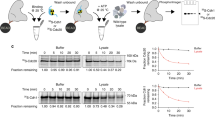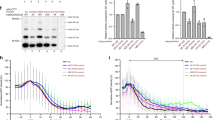Abstract
The anaphase-promoting complex/cyclosome (APC/C) is a 22S ubiquitin ligase complex that initiates chromosome segregation and mitotic exit. We have used biochemical and electron microscopic analyses of Saccharomyces cerevisiae and human APC/C to address how the APC/C subunit Doc1 contributes to recruitment and processive ubiquitylation of APC/C substrates, and to understand how APC/C monomers interact to form a 36S dimeric form. We show that Doc1 interacts with Cdc27, Cdc16 and Apc1 and is located in the vicinity of the cullin–RING module Apc2–Apc11 in the inner cavity of the APC/C. Substrate proteins also bind in the inner cavity, in close proximity to Doc1 and the coactivator Cdh1, and induce conformational changes in Apc2–Apc11. Our results suggest that substrates are recruited to the APC/C by binding to a bipartite substrate receptor composed of a coactivator protein and Doc1.
This is a preview of subscription content, access via your institution
Access options
Subscribe to this journal
Receive 12 print issues and online access
$189.00 per year
only $15.75 per issue
Buy this article
- Purchase on Springer Link
- Instant access to full article PDF
Prices may be subject to local taxes which are calculated during checkout








Similar content being viewed by others
References
Peters, J.M. The anaphase promoting complex/cyclosome: a machine designed to destroy. Nat. Rev. Mol. Cell Biol. 7, 644–656 (2006).
Matyskiela, M.E., Rodrigo-Brenni, M.C. & Morgan, D.O. Mechanisms of ubiquitin transfer by the anaphase-promoting complex. J. Biol. 8, 92 (2009).
Musacchio, A. & Salmon, E.D. The spindle-assembly checkpoint in space and time. Nat. Rev. Mol. Cell Biol. 8, 379–393 (2007).
Au, S.W., Leng, X., Harper, J.W. & Barford, D. Implications for the ubiquitination reaction of the anaphase-promoting complex from the crystal structure of the Doc1/Apc10 subunit. J. Mol. Biol. 316, 955–968 (2002).
Wendt, K.S. et al. Crystal structure of the APC10/DOC1 subunit of the human anaphase-promoting complex. Nat. Struct. Biol. 8, 784–788 (2001).
Wang, J., Dye, B.T., Rajashankar, K.R., Kurinov, I. & Schulman, B.A. Insights into anaphase promoting complex TPR subdomain assembly from a CDC26–APC6 structure. Nat. Struct. Mol. Biol. 16, 987–989 (2009).
Zhang, Z. et al. Molecular structure of the N-terminal domain of the APC/C subunit Cdc27 reveals a homo-dimeric tetratricopeptide repeat architecture. J. Mol. Biol. 397, 1316–1328 (2010).
Han, D., Kim, K., Kim, Y., Kang, Y. & Lee, J.Y. Crystal structure of the N-terminal domain of anaphase-promoting complex subunit 7. J. Biol. Chem. 284, 15137–15146 (2009).
Dube, P. et al. Localization of the coactivator Cdh1 and the cullin subunit Apc2 in a cryo-electron microscopy model of vertebrate APC/C. Mol. Cell 20, 867–879 (2005).
Herzog, F. et al. Structure of the anaphase-promoting complex/cyclosome interacting with a mitotic checkpoint complex. Science 323, 1477–1481 (2009).
Ohi, M.D. et al. Structural organization of the anaphase-promoting complex bound to the mitotic activator Slp1. Mol. Cell 28, 871–885 (2007).
Passmore, L.A. et al. Structural analysis of the anaphase-promoting complex reveals multiple active sites and insights into polyubiquitylation. Mol. Cell 20, 855–866 (2005).
Vodermaier, H.C., Gieffers, C., Maurer-Stroh, S., Eisenhaber, F. & Peters, J.M. TPR subunits of the anaphase-promoting complex mediate binding to the activator protein CDH1. Curr. Biol. 13, 1459–1468 (2003).
Schwickart, M. et al. Swm1/Apc13 is an evolutionarily conserved subunit of the anaphase-promoting complex stabilizing the association of Cdc16 and Cdc27. Mol. Cell. Biol. 24, 3562–3576 (2004).
Thornton, B.R. et al. An architectural map of the anaphase-promoting complex. Genes Dev. 20, 449–460 (2006).
Passmore, L.A. et al. Doc1 mediates the activity of the anaphase-promoting complex by contributing to substrate recognition. EMBO J. 22, 786–796 (2003).
Carroll, C.W. & Morgan, D.O. The Doc1 subunit is a processivity factor for the anaphase-promoting complex. Nat. Cell Biol. 4, 880–887 (2002).
Grossberger, R. et al. Characterization of the DOC1/APC10 subunit of the yeast and the human anaphase-promoting complex. J. Biol. Chem. 274, 14500–14507 (1999).
Gieffers, C., Schleiffer, A. & Peters, J.M. Cullins and cell cycle control. Protoplasma 211, 20–28 (2000).
Carroll, C.W., Enquist-Newman, M. & Morgan, D.O. The APC subunit Doc1 promotes recognition of the substrate destruction box. Curr. Biol. 15, 11–18 (2005).
Hwang, L.H. & Murray, A.W. A novel yeast screen for mitotic arrest mutants identifies DOC1, a new gene involved in cyclin proteolysis. Mol. Biol. Cell 8, 1877–1887 (1997).
Brunner, J. New photolabeling and crosslinking methods. Annu. Rev. Biochem. 62, 483–514 (1993).
Zachariae, W., Shin, T.H., Galova, M., Obermaier, B. & Nasmyth, K. Identification of subunits of the anaphase-promoting complex of Saccharomyces cerevisiae. Science 274, 1201–1204 (1996).
Campbell, R.E. et al. A monomeric red fluorescent protein. Proc. Natl. Acad. Sci. USA 99, 7877–7882 (2002).
Häcker, I. et al. Localization of Prp8, Brr2, Snu114 and U4/U6 proteins in the yeast tri-snRNP by electron microscopy. Nat. Struct. Mol. Biol. 15, 1206–1212 (2008).
Hall, M.C., Torres, M.P., Schroeder, G.K. & Borchers, C.H. Mnd2 and Swm1 are core subunits of the Saccharomyces cerevisiae anaphase-promoting complex. J. Biol. Chem. 278, 16698–16705 (2003).
Yoon, H.J. et al. Proteomics analysis identifies new components of the fission and budding yeast anaphase-promoting complexes. Curr. Biol. 12, 2048–2054 (2002).
Kraft, C., Vodermaier, H.C., Maurer-Stroh, S., Eisenhaber, F. & Peters, J.M. The WD40 propeller domain of Cdh1 functions as a destruction box receptor for APC/C substrates. Mol. Cell 18, 543–553 (2005).
Matyskiela, M.E. & Morgan, D.O. Analysis of activator-binding sites on the APC/C supports a cooperative substrate-binding mechanism. Mol. Cell 34, 68–80 (2009).
Burton, J.L., Tsakraklides, V. & Solomon, M.J. Assembly of an APC-Cdh1-substrate complex is stimulated by engagement of a destruction box. Mol. Cell 18, 533–542 (2005).
Burton, J.L. & Solomon, M.J. D box and KEN box motifs in budding yeast Hsl1p are required for APC-mediated degradation and direct binding to Cdc20p and Cdh1p. Genes Dev. 15, 2381–2395 (2001).
Kastner, B. et al. GraFix: sample preparation for single-particle electron cryomicroscopy. Nat. Methods 5, 53–55 (2008).
Passmore, L.A. & Barford, D. Coactivator functions in a stoichiometric complex with anaphase-promoting complex/cyclosome to mediate substrate recognition. EMBO Rep. 6, 873–878 (2005).
Burton, J.L. & Solomon, M.J. Mad3p, a pseudosubstrate inhibitor of APCCdc20 in the spindle assembly checkpoint. Genes Dev. 21, 655–667 (2007).
Sheff, M.A. & Thorn, K.S. Optimized cassettes for fluorescent protein tagging in Saccharomyces cerevisiae. Yeast 21, 661–670 (2004).
Passmore, L.A., Barford, D. & Harper, J.W. Purification and assay of the budding yeast anaphase-promoting complex. Methods Enzymol. 398, 195–219 (2005).
Gieffers, C., Dube, P., Harris, J.R., Stark, H. & Peters, J.M. Three-dimensional structure of the anaphase-promoting complex. Mol. Cell 7, 907–913 (2001).
Acknowledgements
We are grateful to I. Häcker (Max Planck Institute for Biophysical Chemistry, Göttingen) and M. Madalinski (IMP, Vienna) for technical assistance; J. Barrett (Zentrum für Molekulare Biologie, Heidelberg), J. Brunner (Eidgenössische Technische Hochschule Zürich), D. Finley (Harvard Medical School, Boston), U. Hoya (Friedrich-Alexander-Universität, Erlangen), D. Morgan (University of California, San Francisco), K. Nasmyth (University of Oxford), M. Solomon (Yale University) and W. Zachariae (Max Planck Institute of Molecular Cell Biology and Genetics, Dresden) for kindly providing yeast strains and reagents; and J. Barrett, J. Brunner and B. Martoglio (Eidgenössische Technische Hochschule Zürich) for advice on photo-cross-linking. Research in the laboratory of H.S. was supported by grants from the Federal Ministry of Education and Research, Germany, and from the Sixth Framework Programme of the European Union via the Integrated Project 3DRepertoire. Research in the laboratory of J.-M.P. is supported by Boehringer Ingelheim, the Vienna Spots of Excellence Programme and the Austrian Science Fund.
Author information
Authors and Affiliations
Contributions
H.S. and J.-M.P. planned and supervised the project. B.A.B., G.P., C.K. and F.H. designed the experiments. B.A.B. performed most of the photo-cross-linking and biochemical experiments on yeast APC/C. G.P. performed the experiments on substrate bound APC/C. M.G. and C.K. generated yeast strains and performed growth assays and yeast APC/C purifications. F.H. performed antibody labeling on human APC/C. P.D. performed EM. H.S. calculated and analyzed the 3D EM structures. B.A.B., G.P. and J.-M.P. wrote the paper.
Corresponding authors
Ethics declarations
Competing interests
The authors declare no competing financial interests.
Supplementary information
Supplementary Text and Figures
Supplementary Methods, Supplementary Figures 1–5 and Supplementary Tables 1–5 (PDF 3974 kb)
Rights and permissions
About this article
Cite this article
Buschhorn, B., Petzold, G., Galova, M. et al. Substrate binding on the APC/C occurs between the coactivator Cdh1 and the processivity factor Doc1. Nat Struct Mol Biol 18, 6–13 (2011). https://doi.org/10.1038/nsmb.1979
Received:
Accepted:
Published:
Issue Date:
DOI: https://doi.org/10.1038/nsmb.1979



